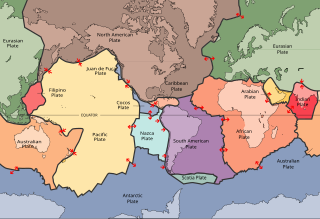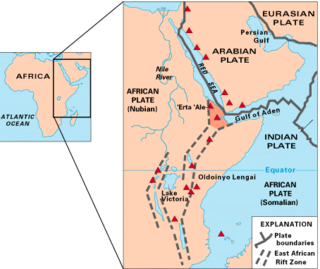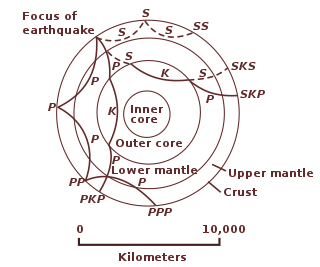
Plate tectonics is the scientific theory that Earth's lithosphere comprises a number of large tectonic plates, which have been slowly moving since 3–4 billion years ago. The model builds on the concept of continental drift, an idea developed during the first decades of the 20th century. Plate tectonics came to be accepted by geoscientists after seafloor spreading was validated in the mid-to-late 1960s.

Geophysics is a subject of natural science concerned with the physical processes and physical properties of the Earth and its surrounding space environment, and the use of quantitative methods for their analysis. Geophysicists, who usually study geophysics, physics, or one of the Earth sciences at the graduate level, complete investigations across a wide range of scientific disciplines. The term geophysics classically refers to solid earth applications: Earth's shape; its gravitational, magnetic fields, and electromagnetic fields ; its internal structure and composition; its dynamics and their surface expression in plate tectonics, the generation of magmas, volcanism and rock formation. However, modern geophysics organizations and pure scientists use a broader definition that includes the water cycle including snow and ice; fluid dynamics of the oceans and the atmosphere; electricity and magnetism in the ionosphere and magnetosphere and solar-terrestrial physics; and analogous problems associated with the Moon and other planets.

A lithosphere is the rigid, outermost rocky shell of a terrestrial planet or natural satellite. On Earth, it is composed of the crust and the lithospheric mantle, the topmost portion of the upper mantle that behaves elastically on time scales of up to thousands of years or more. The crust and upper mantle are distinguished on the basis of chemistry and mineralogy.

Subduction is a geological process in which the oceanic lithosphere and some continental lithosphere is recycled into the Earth's mantle at the convergent boundaries between tectonic plates. Where one tectonic plate converges with a second plate, the heavier plate dives beneath the other and sinks into the mantle. A region where this process occurs is known as a subduction zone, and its surface expression is known as an arc-trench complex. The process of subduction has created most of the Earth's continental crust. Rates of subduction are typically measured in centimeters per year, with rates of convergence as high as 11 cm/year.

Tectonics are the processes that result in the structure and properties of the Earth's crust and its evolution through time.
Seismic tomography or seismotomography is a technique for imaging the subsurface of the Earth with seismic waves produced by earthquakes or explosions. P-, S-, and surface waves can be used for tomographic models of different resolutions based on seismic wavelength, wave source distance, and the seismograph array coverage. The data received at seismometers are used to solve an inverse problem, wherein the locations of reflection and refraction of the wave paths are determined. This solution can be used to create 3D images of velocity anomalies which may be interpreted as structural, thermal, or compositional variations. Geoscientists use these images to better understand core, mantle, and plate tectonic processes.
Tectonophysics, a branch of geophysics, is the study of the physical processes that underlie tectonic deformation. This includes measurement or calculation of the stress- and strain fields on Earth’s surface and the rheologies of the crust, mantle, lithosphere and asthenosphere.

The East African Rift (EAR) or East African Rift System (EARS) is an active continental rift zone in East Africa. The EAR began developing around the onset of the Miocene, 22–25 million years ago. It was formerly considered to be part of a larger Great Rift Valley that extended north to Asia Minor.
Dan Peter McKenzie is a Professor of Geophysics at the University of Cambridge, and one-time head of the Bullard Laboratories of the Cambridge Department of Earth Sciences. He wrote the first paper defining the mathematical principles of plate tectonics on a sphere, and his early work on mantle convection created the modern discussion of planetary interiors.

Don Lynn Anderson was an American geophysicist who made significant contributions to the understanding of the origin, evolution, structure, and composition of Earth and other planets. An expert in numerous scientific disciplines, Anderson's work combined seismology, solid state physics, geochemistry and petrology to explain how the Earth works. Anderson was best known for his contributions to the understanding of the Earth's deep interior, and more recently, for the plate theory hypothesis that hotspots are the product of plate tectonics rather than narrow plumes emanating from the deep Earth. Anderson was Professor (Emeritus) of Geophysics in the Division of Geological and Planetary Sciences at the California Institute of Technology (Caltech). He received numerous awards from geophysical, geological and astronomical societies. In 1998 he was awarded the Crafoord Prize by the Royal Swedish Academy of Sciences along with Adam Dziewonski. Later that year, Anderson received the National Medal of Science. He held honorary doctorates from Rensselaer Polytechnic Institute and the University of Paris (Sorbonne), and served on numerous university advisory committees, including those at Harvard, Princeton, Yale, University of Chicago, Stanford, University of Paris, Purdue University, and Rice University. Anderson's wide-ranging research resulted in hundreds of published papers in the fields of planetary science, seismology, mineral physics, petrology, geochemistry, tectonics and the philosophy of science.

The International Union of Geodesy and Geophysics is an international non-governmental organization dedicated to the scientific study of Earth and its space environment using geophysical and geodetic techniques.

Geodynamics is a subfield of geophysics dealing with dynamics of the Earth. It applies physics, chemistry and mathematics to the understanding of how mantle convection leads to plate tectonics and geologic phenomena such as seafloor spreading, mountain building, volcanoes, earthquakes, faulting. It also attempts to probe the internal activity by measuring magnetic fields, gravity, and seismic waves, as well as the mineralogy of rocks and their isotopic composition. Methods of geodynamics are also applied to exploration of other planets.

Paul Gordon Silver was an American seismologist. A member of the research staff at the Department of Terrestrial Magnetism of the Carnegie Institution of Washington since 1982, Paul Silver made a series of important contributions to the investigation of seismic anisotropy and to earthquake research by observing the slow redistribution of stress and strain along fault zones.

The following outline is provided as an overview of and topical guide to geophysics:

Walter D. Mooney is a research seismologist and geophysicist at the United States Geological Survey (USGS), Menlo Park, California (1978–present). He was Chief of the USGS Branch of Seismology from 1994 to 1997.
The 1139 Ganja earthquake was one of the worst seismic events in history. It affected the Seljuk Empire and Kingdom of Georgia; modern-day Azerbaijan and Georgia. The earthquake had an estimated magnitude of 7.7 , 7.5 and 7.0–7.3 . A controversial death toll of 230,000–300,000 came as a consequence of this event.

Hans Thybo is a Danish geophysicist and geologist. He is President of International Lithosphere Program since 2017 and currently employed by the Chinese Academy of Geological Sciences (CAGS).

Irina M. Artemieva is Professor of Geophysics at the GEOMAR Helmholtz Centre for Ocean Research in Kiel (Germany), Distinguished Professor at the China University of Geosciences (Wuhan), and Distinguished Professor at SinoProbe at the Chinese Academy of Geological Sciences (Beijing).
Kelin Wang is a senior research scientist and has worked for the Geological Survey of Canada since 1992. His research encompasses geodynamics and natural hazards, with major contributions in researching slow-slip events along the Cascadia subduction interface.
James Gregory "Greg" Hirth is an American geophysicist, specializing in tectonophysics. He is known for his experiments in rock deformation and his applications of rheology in development of models for tectonophysics.













